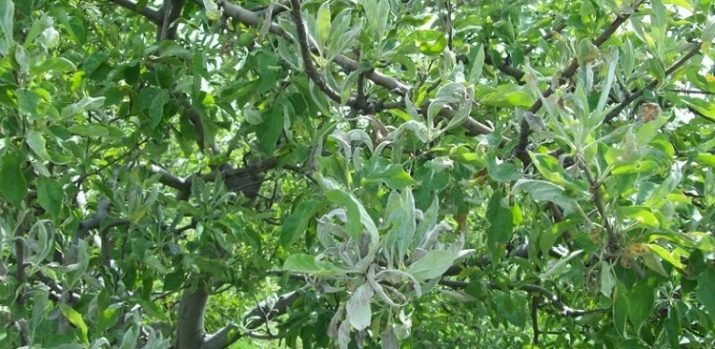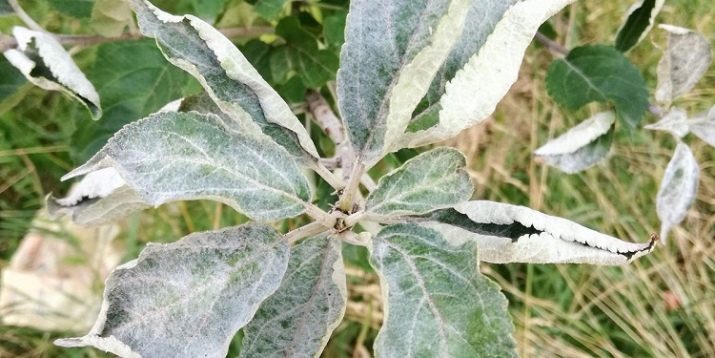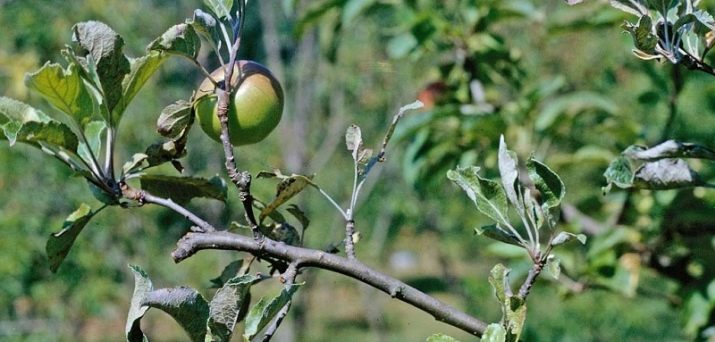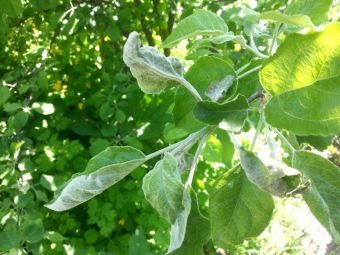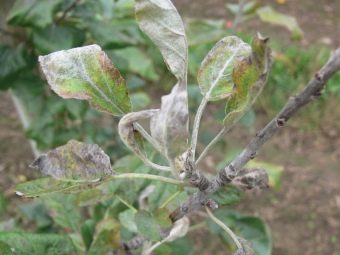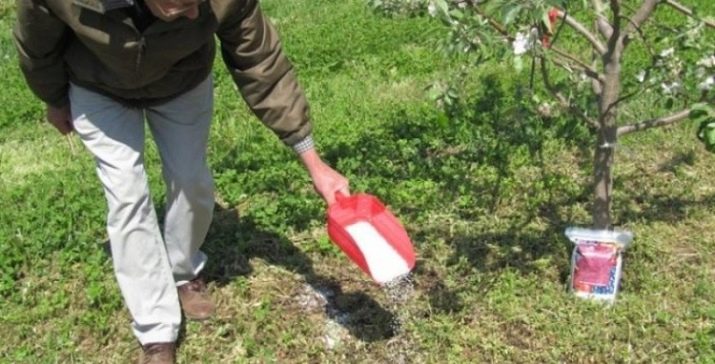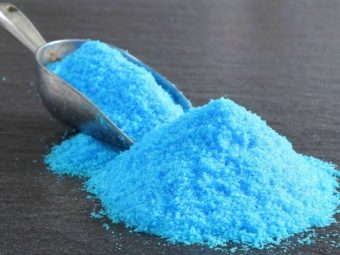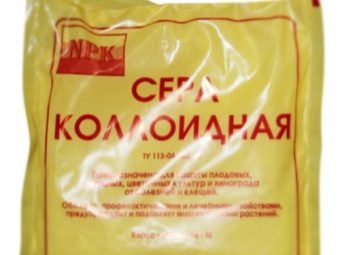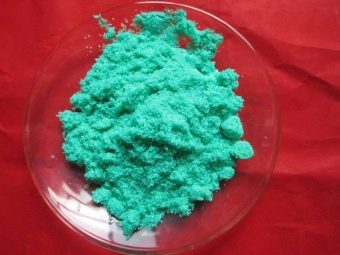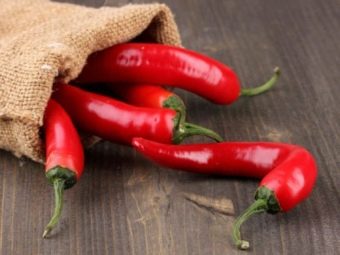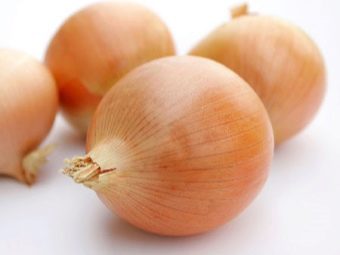Mealy dew on an apple tree: why did it appear and how to fight?
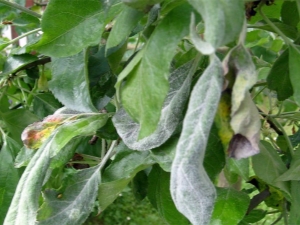
Mealy dew on apple trees is found in all regions of the world where this plant grows.The disease causes serious damage, spoiling the quality of the fruit. On the methods of dealing with the disease will tell our article.
Symptoms and signs
Mealy dew infects young shoots, leaves, flowers and fruits. The symptoms are most noticeable on the leaves and fruits.
Overwintering in dormant flower and sprouting buds, infection infects the tree for the next year. In the spring, when the first leaves open, the fungus invades the young green tissue of the plant. Infected kidneys have a silvery gray appearance. Often, during the spring development of an apple tree, the first leaves are falling, and their growth is slow.
Subsequently, as the plant forms color and fruits, the infection begins to penetrate deeper into the leaves, flowers and apples. Strongly affected trees weaken by the middle of summer, powdery mildew mycelium darkens and is covered with numerous processes.
In contrast to the primary infection, in which the leaf is affected even before it leaves the kidney, the secondary occurs when powdery mildew spores land on already opened foliage. Fungal colonies consisting of mycelium and spores appear as a white patina. Secondary infection appears first on the lower surface of the leaf, less often on the upper in the form of chlorotic spots. Leaves infected along the edge may curl or fold longitudinally. As the disease progresses, the affected tissues begin to acquire a silvery gray tint.
Infection on the flower or young fruit leads to discoloration and shape distortion. The yield and quality of apples decreases. Infected buds have a silver-gray appearance and open 5-8 days later healthy, if they bloom at all. The petals are modified and have a pale yellow or light green tint.
Inflorescences can become shriveled, they rarely bear fruit. Secondary infection occurs on the newly formed flower buds. This is one of the main reasons why there is no harvest the next year after the defeat of powdery mildew.
Appearance and distribution
Trees affect the fungus, which is found in every region where apple orchards grow. During the growing season, the colony constantly generates spores of asexual reproduction on short petioles. Spores do not need moisture to germinate and they spread very quickly to the wind. If they land on susceptible tissues, new mycelium colonies are produced.
Apple buds serve as wintering grounds and are the earliest source of infection next spring. However, extremely low winter temperatures adversely affect the survival of the powdery mildew.
The fungus also produces genital spores in fruit bodies. They are tightly grouped and have apical and basal appendages. They are formed at the end of the growing season and serve as wintering structures, but do not play any role in creating a new epidemic, since they do not germinate well. Fungus winters in:
- sleeping flower;
- runaway;
- the kidneys.
In the spring, when the plant begins to wake up, the fungus resumes growth, striking new shoots and young leaves. This primary infection is the main cause of the epidemic, since disputes are spread in large numbers after a short period of time. They will germinate at high relative humidity (more than 70%, which is usually present in the microclimate of the lower surface of the sheet) and at a temperature of 10 to 25 ° C. Unlike most of these fungal pathogens, leaf wetting is a deterrent to infection. The youngest leaves are most susceptible, but become more resilient as they grow.
Mold colonies usually appear first on the bottom surface of the sheet in the form of white felt spots. Spores germinate, forming growths that swell and then flatten out. These structures release specific enzymes that allow the fungal infection to invade the epidermal cells.
The fungus lives and eats due to haustoria.These are organs that form inside the living cell and absorb nutrients from the plant. As the mold colony expands and secondary infection leads to the formation of a new colony, the process does not stop until the tissue suitable for feeding the fungus disappears.
Methods of struggle
It is possible and necessary to fight the disease, for this you need to spend some of your own time, but thanks to work you can get a high-quality and rich harvest. Experienced gardeners offer several ways to fight infection:
- sluggish and lifeless shoots and leaves must be removed;
- all residues after pruning, including old leaves, must be burned;
- on the ground around the tree, it is necessary to pour ashes with a layer thickness of at least a centimeter;
- it is necessary to make regular dressings using potassium and phosphorus;
- In the fall and spring, trees are necessarily treated with fungicides.
When spraying the plants, they must “bathe in the solution”, that is, it is necessary to apply it so that each bud and shoot are covered with the preparation. Moreover, the ground around the tree is also cultivated.
Chemicals
Secondary infections and infections of the fruit can be controlled by the use of fungicides. These drugs are almost always used to combat mold and other apple diseases. Fungicides are usually used with an interval of 7 to 10 days from the stage of dense breeding until the end of the growth of shoots, and this is about the middle of summer. Susceptible apple varieties have to be processed up to 18 times per season, if you need to preserve the crop. As far as possible, the use of drugs should be alternated with other actions. Experts advise to use sulfur in a period of low risk of infection with powdery mildew and plant varieties less susceptible to the fungus.
Benzimidazoles have a high activity against the fungus, but their use has not been particularly popular lately. Special oils, waxes and biological compounds are also available, but their effectiveness is somewhat controversial. It is difficult to provide the necessary control during the growing season if the problem was ignored at an early stage.
Most effective tools are composed of:
- copper sulphate;
- colloidal sulfur;
- copper chloride.
It is necessary to use them strictly in accordance with the instructions. As practice shows, the funds, which are based on sulfur, have a better effect on the fungus. Often you can hear about the fight against powdery mildew with antibiotics, but this makes no sense.
Copper sulfate can be used only once per season, as it has a strong fungicidal effect. It is advisable to use it in the spring, before the first buds bloom. Ten grams of water will need 50 grams of vitriol. There is another recipe: dilute 30 grams of the product in half a liter, dilute the soap in the remaining nine liters of water. When spraying on plants, be sure to use personal protective equipment.
A good remedy is colloidal sulfur, which can be used even three days before picking apples. Ten liters of water will require 50 grams of sulfur. Allowed up to six sprays per season. An important condition is that the air temperature should not be below +20 degrees, otherwise the treatment will not bring success.
Folk remedies
Not all gardeners love to use powdery mildew chemicals and resort to popular recipes. The infusions on tobacco, hot pepper, tansy and celandine proved to be good. So that the solutions are not washed away with precipitation from the tree too quickly, it is necessary to add household, tar or just liquid soap.
To prepare ten liters of tartan infusion, you need only 7 grams of powder. It must be poured with boiling water and left for a day or two, then boiled again and filtered before use. Infusion can be used several times.
Does not like fungus and hot peppers. A kilogram of fruit is infused for 48 hours in boiling water, then the infusion is brought to a boil and the concentrate is poured into containers. It does not disappear all season, therefore it can be used at any time.
But celandine, dandelion and onions can not insist, it is enough to finely chop them, dry, grind into flour and sprinkle wood. This treatment is effective, but it is better to carry out the procedure in the spring, before the first foliage appears.
About why powdery mildew appeared on the apple tree and how to deal with it, see the next video.

